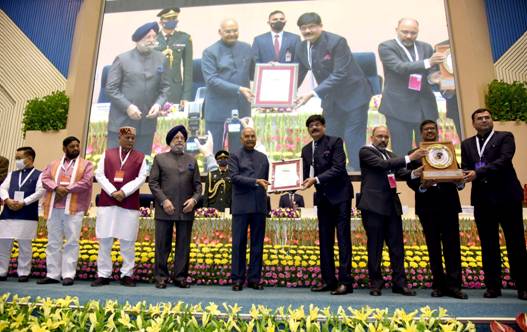Every year, Navi Mumbai witnesses a breathtaking spectacle as thousands of lesser flamingos (Phoeniconaias minor) flock to its wetlands, painting the shores in hues of delicate pink.
These mesmerizing birds, known for their vibrant plumage and elegant courtship rituals, create a stunning visual treat for birdwatchers, photographers, and nature enthusiasts alike. The annual arrival of these winged visitors signifies the ecological significance of Mumbai’s wetlands, offering a rare glimpse into the fascinating lives of these migratory wonders.
The Enchanting Pink Plumage
Lesser flamingos are distinguished by their distinctive pink feathers, a hallmark of their species. This striking colouration is not merely an aesthetic trait but a result of their diet. These birds primarily feed on blue-green algae (cyanobacteria) and microscopic organisms rich in carotenoid pigments. The pigments are metabolized and deposited in their feathers, giving them their characteristic rosy hue. The deeper the pink, the healthier and more well-nourished the bird is.
Interestingly, young flamingos are born with greyish-white feathers, and they gradually acquire their signature pink as they mature. The intensity of their colouration often plays a crucial role in their social dynamics and mating success, with more vibrantly coloured flamingos being perceived as stronger and more attractive mates.
The Annual Migration to Navi Mumbai
Lesser flamingos are primarily found in Africa and parts of South Asia. While large populations thrive in East Africa’s soda lakes and the Rann of Kutch in Gujarat, India, thousands migrate annually to the wetlands of Navi Mumbai, particularly to areas like Thane Creek, Sewri Mudflats, and the Talawe Wetlands.
Their arrival, typically between November and May, transforms these landscapes into vibrant ecosystems bustling with activity. These migratory birds favor shallow saline and brackish waters, which provide them with ample food sources. Despite being surrounded by urban development, Mumbai’s wetlands offer a crucial feeding and resting ground for these birds. Conservationists have long emphasized the need to preserve these habitats, as rapid urbanization threatens their seasonal refuge.
The Graceful Courtship Displays
One of the most fascinating aspects of the lesser flamingo’s life is its elaborate courtship display. During the breeding season, which coincides with their stay in Mumbai, flamingos engage in synchronized group displays to attract potential mates. These courtship rituals are a spectacle of nature, marked by a series of synchronized movements such as head-flagging, wing-saluting, and coordinated marching.
The “head-flagging” movement involves a group of flamingos rhythmically raising and turning their heads from side to side in unison, creating a mesmerizing dance-like sequence. “Wing-saluting” is another intriguing behaviour where they spread their wings to showcase the contrasting black flight feathers, adding an extra layer of allure to their display.
These synchronized movements not only serve to impress potential mates but also strengthen social bonds within the flock. Once paired, flamingos build mud nests in colonies, where females lay a single egg. Both parents share the responsibility of incubating the egg and feeding the chick with a special nutrient-rich secretion called “crop milk.”
Challenges and Conservation Efforts
Despite their resilience and adaptability, lesser flamingos face several threats, particularly due to habitat destruction, pollution, and climate change. The rapid urbanization of Mumbai has led to the encroachment of vital wetland habitats, posing a serious challenge to their survival. Increased industrial activities, plastic pollution, and rising water contamination levels further endanger these birds.
Conservationists and environmentalists have been actively working to safeguard Mumbai’s wetlands by advocating for sustainable urban planning and stricter protective measures. Organizations and birdwatching groups frequently conduct awareness campaigns to educate the public about the importance of preserving these habitats for flamingos and other migratory birds.
Additionally, initiatives such as declaring Thane Creek as a Flamingo Sanctuary have played a pivotal role in promoting conservation efforts. The sanctuary, officially recognized in 2015, provides a relatively safe haven for these birds, helping to ensure their continued migration to the region.
A Symbol of Resilience and Beauty
The annual migration of lesser flamingos to Navi Mumbai is not just a visual delight but also a poignant reminder of nature’s delicate balance. These birds symbolize resilience, grace, and the interconnectedness of ecosystems. Their presence in the city’s wetlands is a testament to Mumbai’s rich biodiversity, highlighting the urgent need to protect these crucial environments.
As another flamingo season unfolds, nature lovers eagerly anticipate the return of these exquisite creatures, hoping to witness once again the dance of pink against the shimmering waters. By fostering awareness and promoting conservation efforts, we can ensure that future generations continue to marvel at the breathtaking spectacle of lesser flamingos gracing Mumbai’s shores, year after year.
This Bird was photographed and Video Covered at Navi Mumbai, Maharashtra, India
Special thanks to the CIS-A2K and Wiki Loves Birds & Wikipedia Team.

K. Shiva Kumar: Wildlife Storyteller
These rare photographs have been clicked and contributed by K. Shiva Kumar, a professional Wildlife Storyteller (M.A in Journalism & Mass Communication, an alumnus of Central University Of Odisha, Koraput) from Hyderabad, Telangana.





